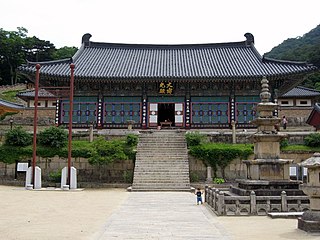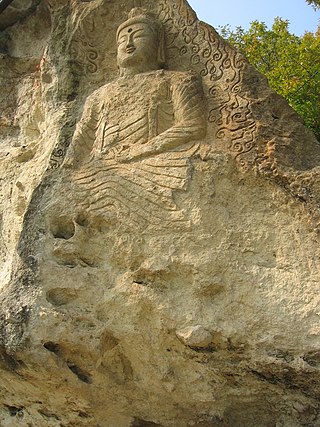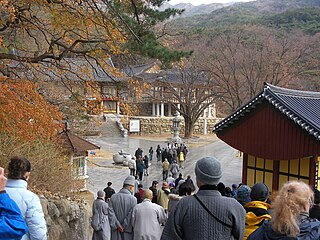
Haeinsa is a head temple of the Jogye Order of Korean Seon Buddhism in Gayasan National Park, South Gyeongsang Province, South Korea. Haeinsa is most notable for being the home of the Tripitaka Koreana, the whole of the Buddhist Scriptures carved onto 81,350 wooden printing blocks, which it has housed since 1398.

Bulguksa is located on the slopes of Mount Toham. It is a head temple of the Jogye Order of Korean Buddhism and encompasses six National treasures of South Korea, including the Dabotap and Seokgatap stone pagodas, Cheongun-gyo, and two gilt-bronze statues of Buddha. The temple is classified as Historic and Scenic Site No. 1 by the South Korean government. In 1995, Bulguksa was added to the UNESCO World Heritage List together with the Seokguram Grotto, which lies four kilometers to the east.

A National Treasure is a tangible treasure, artifact, site, or building which is recognized by the South Korean government as having exceptional artistic, cultural and historical value to the country. The title is one of the eight State-designated heritage classifications assigned by the administrator of the Cultural Heritage Administration (CHA) in accordance with the Cultural Heritage Protection Act after deliberation by the Cultural Heritage Committee.

Golgulsa is located 20 km east of the ancient Silla Dynasty capital city of Gyeongju in Southeastern Korea. In the Golgulsa temple area can be found the oldest historical Buddhist ruins on Mt. Hamwol and the only cave temple in Korea.

Donghwasa, also Donghwa Temple, is a Buddhist temple of the Jogye Order in northern Daegu, South Korea. The temple is located on the south side of Mt. Palgongsan, within the boundaries of Dohak-dong, Dong-gu, near Daegu's northern border. The name means "Temple of Paulownia Blossoms."

Jogyesa is the chief temple of the Jogye Order of Korean Buddhism. The building dates back to the late 14th century and became the order's chief temple in 1936. It thus plays a leading role in the current state of Seon Buddhism in South Korea. The temple was first established in 1395, at the dawn of the Joseon Dynasty; the modern temple was founded in 1910 and initially called "Gakhwangsa". The name was changed to "Taegosa" during the period of Japanese rule, and then to the present name in 1954.

Sudeoksa is a head temple of the Jogye Order of Korean Buddhism. It is located on the southern slopes of Deoksungsan in Deoksan-myeon, Yesan County, South Chungcheong Province, South Korea.

Beopjusa, is a head temple of the Jogye Order of Korean Buddhism. It is situated on the slopes of Songnisan, within Songnisan National Park, in Naesongni-myeon, Boeun County, in the province of Chungcheongbuk-do, South Korea.

Woljeongsa is a head temple of the Jogye Order of Korean Buddhism, located on the eastern slopes of Odaesan in Pyeongchang County, Gangwon Province, South Korea. Woljeongsa was founded in 643 by the Silla monk Jajang.

Yongjoosa is a head temple of the Jogye Order of Korean Buddhism. It is located in on the slopes of Hwasan in Taean-eup, Hwaseong, in the province of Gyeonggi, South Korea. The temple's name means "dragon jewel temple."

Seonunsa is a head temple of the Jogye Order of Korean Buddhism. It stands on the slopes of Dosolsan in Asan-myeon, Gochang County, near the Yellow Sea coast in western Jeollabuk-do province.

Hwaeomsa is a head temple of the Jogye Order of Korean Buddhism. It is located on the slopes of Jirisan, in Masan-myeon, Gurye County, in South Jeolla Province, South Korea.

Geumsansa is a temple of the Jogye Order of Korean Buddhism standing on the slopes of Moaksan in Gimje City, Jeollabuk-do, South Korea.

Unjusa or Unju Temple is a Korean Buddhist temple located in Hwasun County, South Jeolla province, South Korea. It is 26 km (16 mi) southwest of Hwasun County or 40 km (24 mi) south of Gwangju. Compared with other temples in South Korea, this temple has an unusual collection of stone Buddha statues and stone pagodas, so Unjusa is often referred to as the mysterious temple. Among several assumptions regarding its origin, the most widely known one is that Monk Doseon founded the temple based on geomancy during the late period of Silla Dynasty, but the origins remain unverified.

Shilleuksa is a Korean Buddhist temple situated against a low hill on the north side of the river Namhan, three kilometers east of Yeoju in Gyeonggi Province, approximately one-hour southeast of Seoul. The only riverside temple in South Korea, Shilleuksa is a sacred pilgrimage site and a repository of seven Treasures. A 500-year-old aromatic juniper tree and a 600-year-old ginkgo tree stand on the temple grounds.

Myogaksa Temple is a Korean Buddhist temple located in the heart of downtown Seoul, South Korea, in the Jongro District, nestled on the east side of Naksan Mountain. It houses the administrative headquarters of the Gwaneum Order of Korean Buddhism. It is located close to the Dongmangbong Peak, Naksan Park, Donggwanmyo Shrine and Dongdaemun Market.

Seonam Temple, or Seonamsa, is a Korean Buddhist temple on the eastern slope at the west end of Jogyesan Provincial Park, within the northern Seungjumyeon District of the city of Suncheon, South Jeolla Province, South Korea. It belongs to the Taego Order although the Jogye Order claims possession over it.

Yongmunsa is a Buddhist temple of the Jogye Order in Yangpyeong county, South Korea.

Samhwasa is a Buddhist temple of the Jogye Order in Gangwon, South Korea.


































